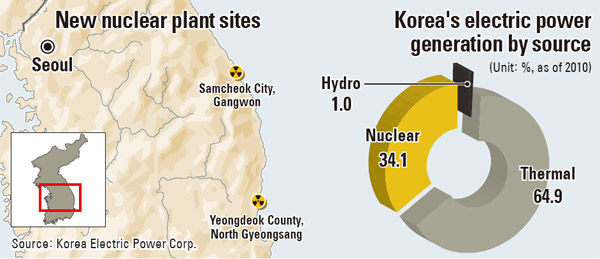Sites of 2 new nuclear plants named

Korea Hydro and Nuclear Power Co. on Thursday night disclosed candidate sites for two nuclear power plants: Yeongdeok County, North Gyeongsang, and Samcheok City, Gangwon.
The state-run power company plans to conduct an environmental study before it files an application to designate the sites for the plants in early next year.
If they are built, the two plants will have four reactors each with a capacity of 1.4 million kilowatts each. It will take 12 years to build them. The plants will have APR1400 reactors, the same reactor that is being exported to the United Arab Emirates.
The government originally intended to announce the sites by last June but due to the catastrophic nuclear accident in Fukushima, Japan, in March, the decision was delayed.
The government will go ahead with its plan to increase nuclear power generation due to Korea’s increasing electricity demand. The Korea Development Institute estimated that electricity consumption will grow by an average of 1.9 percent a year between 2010 and 2024.
Korea has 21 nuclear plants and they are located in Yeonggwang, South Jeolla; Uljin, North Gyeongsang; and Wolseong, Gori and Singori in South Gyeongsang.
Under the country’s nuclear power road map, Korea’s reliance on nuclear energy in terms of electricity production will grow from 34.1 percent in 2010 to 48.9 percent in 2020 and 59 percent in 2030. Under the plan, Korea would need a total of 39 nuclear reactors by 2030.
“Because of safety concerns, we intend to take potential effects of a tsunami and earthquake into account when we design nuclear power plants,” Jeong In-su, an executive at Korea Hydro and Nuclear Power, told the press yesterday. “We will also make sure that electricity can continue to be supplied to cooling systems even if a reactor is submerged under water.”
The accidents in Fukushima were caused by cooling systems that went out after plants were hit by the March tsunami.
Nuclear is the least expensive form of energy as it cost 39.7 won (3 cents) to produce 1 Kilowatt-hour compared to 566.9 won for solar, 187.8 won for oil, 133.5 won for hydro and 107.2 won for wind power.
By Limb Jae-un [jbiz91@joongang.co.kr]










with the Korea JoongAng Daily
To write comments, please log in to one of the accounts.
Standards Board Policy (0/250자)